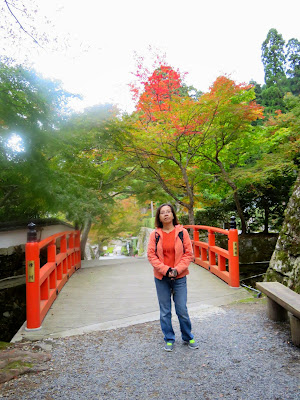
There are several small scheme temples in the vicinity near Sanzen-in Complex and almost all of them adhered to Tendai Sect of Japanese Buddhism. Temple Jikko-in at north of Sanzen-in as many others at site, was built to service Buddhist practices and ceremonies with music and melodies, a kind of Buddhist ritual introduced from China. Jikko-in was established by Priest Jikaku Enin (794-864) who was a disciple of Master Saicho (767-822), founder of Tendai sect Buddhism.



The Hall dedicated to Boddhisattva Samantabhadra (Puxian Pusa) was awesome.


Temple Shorin-in was built in year 1013 by Jakugen, a disciple of priest En-nin (794-864). It was originally constructed as a place of practice but later became a learning center of Hogi Shomyo, kind of Buddhist ritual introduced by his master from China Tang Dynasty (618-907). The present Hondo main shrine hall was restored during Edo period (1603-1867) in year 1777. Hondo enshrines a famous seated image of Amitabha Buddha that was made in 17th century. The gold gilded Buddha Image of Shomyo and its bell tower are designated by Kyoto City as a tangible cultural property.



The artifacts at grounds including the Tsukubai Wash basin with two bamboo sticks protruding from wooden panels to create water dripping sound as if the Japanese Suikinkutsu water hollow harp (I don't think this was the one, I must have taken a wrong picture).


Hosen-in is a sub-temple of Shorin-in. It was constructed in year 1012 initially as a lodging quarter for main temple. The little temple site was the place where founder of Japanese Pureland Sect, master Honen Sho-nin (1133-1212) had the famous religious debate with Kenshin who was then the chief magistrate of Ohara Temple. Hosen-in Temple is reputable for its blood stained ceiling panels Chi-tenjo at the passage walkway in the 1502 built Library Hall. The wooden panels were used to be the floor panels of Fushimi Castle and stains of blood belonged to Samurais who committed Harakiri suicide when defeated by the enemies.


Hosen-in temple is also well known for its beautiful bamboo garden and also a 700 years old pine tree that had been skillfully pruned and shaped into Mt Fuji. We did not manage to visit its bamboo garden (Its dark when arrived) but the pine garden is impressive. Hosen-in is quite a hot spot for night illumination show in Ohara.


Illustration and a brief history of Shorin-in temple.


Here is a beautiful and serene world, a place that makes you easily putting down all oppressive burdens and bustling thoughts.


Time seems to stand still at a retreat site as this.





The old gate leads to Raigo-in that lies along Rogawa River south of Sanjen-in. Raigo Temple was believed to be a historical site where Japanese folk songs originated. It was the place where ancient ritual of Buddhist chanting and melody was practiced. The temple enshrines images of Amitabha Buddha, Yakushi Medicine Buddha and Shaka Buddha. The three rare wooden sculptures of Buddha were plated with lacquer and gold leaf made probably in 13th century.


The burning red foliage that found within the compound surrounded Sanjen-in temple site.










The walk way from Ohara Town to the temple sites lined with many small shops promoting the local specialties like round radish pickles and aisu kyuri, kind of cucumber pickles in seaweed flavor with bamboo stick soaked in ice water.






Walking along Rogawa river to visit the scenic temple sites of Ohara was one of the most interesting activities in Kyoto.



The handmade pickles were tempting.


Tasty snacks prepared with various flavor were offered at the mouth of the walking lane at a price clearly stated!


A model of Oharame strong woman stood near the lane that was named after it. Oharame was an important part of Ohara's farming root. They wore tradition blue farming dress with twigs and leaves loaded on their heads, selling firewood and vegetables in the villages.



No comments:
Post a Comment